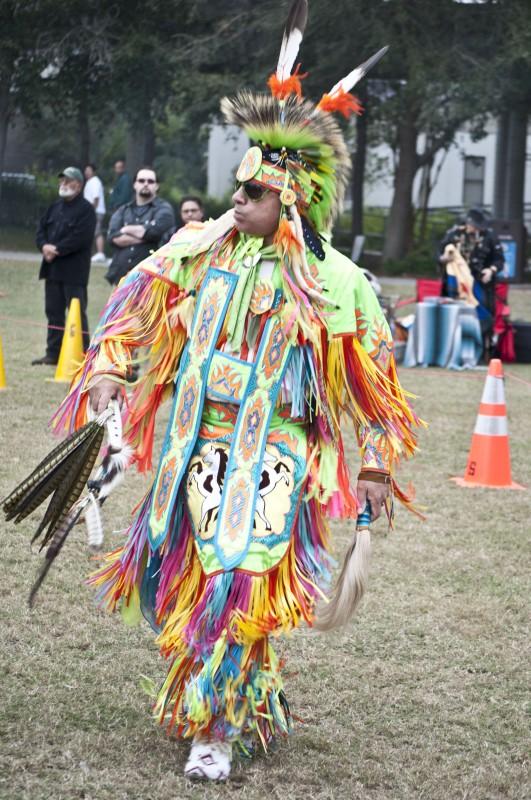 The Grand Entry begins with wafting smoke from burning sage swirling around a dancer wearing his regalia. The smoke purifies, cleanses and aligns her energies as the dance begins.
The Grand Entry begins with wafting smoke from burning sage swirling around a dancer wearing his regalia. The smoke purifies, cleanses and aligns her energies as the dance begins.
This is the commencement of a Pow Wow.
However, since UNF did not have the three days or even a week it takes for a true Pow Wow, the university opted for a daylong Native American Celebration.
Organized by the UNF Intercultural Center for PEACE, the celebration took place on the green Nov. 17. The event’s intent was to educate students and guests about the diversity of the Native American culture, to highlight their sustained presence in the world and to eschew myths that are simply just wrong.
The day was cold and windy. Against the cloudy sky, an array of tents set up along the green offered a range of handmade items and crafts such as feathery hair clips and fox skins.
Curiously, not too many of the participants looked like what Native Americans are normally thought of. Some were what you would call, off-hand, African American, maybe Caucasian or even Hispanic.
But these people are representatives of lines of ancestry that step back thousands of years in the native land that was once theirs. They came to our university to share the richness of their culture.
As a woman prepared to perform with a wooden flute, the MC spoke over the monitor, citing future Pow Wows across the nations and in the regional area where more dancing, singing and rejoicing will take place.
A woman sat under a lean-to that appeared almost dioramic with an assortment of real and prop artifacts including food and jawbone-tools on display, showcasing the older way of life. She cheerfully spoke to anyone about her display and what it means to be a Native American.
The event showed a microcosm of American Indian culture, not our everyday campus green, but a place to learn about the ways of this country’s native people. It was about respect, a foundational feeling of association with the past and history of the culture of the indigenous people. It was also an opportunity to converse with men and women who can tell stories that others cannot.
Nelson RedHawk, who helped bring many of the participating vendors and dancers to the event, felt there was a good representation of the various native people groups.
“We have about 17 different nations represented here,” he said. “Creek, Sioux, Cherokee, Huron, to name a few.”
A Fancy Shawl dancer, Courtney Bell, wrapped herself tightly in her regalia, a cloth displaying colors patterned after those of the monarch butterfly, which are representative of her father’s passing last year.
“If you ask any Native American the reason we dance, they will tell you we dance for the people who cannot dance,” Bell said. “We honor our ancestors by dancing. As soon as I step in the circle my prayer begins, so when I’m dancing i’m really praying.”
Other than educating students and guests about dancing, Bell also wished to tell them that Native Americans are still here. She said although the earth has been good to them, and they to it, there are still many reservations in despicable conditions.
She said at Pine Ridge, her reservation in South Dakota, many of the dwellings are nothing but little shacks. She said reservations are losing more rights and there is a serious poverty issue.
“Not every tribe is like the Seminole, who are really wealthy,” Bell said.
RedHawk said he also wants to dispel myths of all natives being angry, spiteful people.
“I cannot just be that angry Indian. I cannot come here and be that man,” he said. “It is an honor to be here, and I have an obligation to represent my people best because of their struggle. People who have overcame struggle on both sides of my ancestry, both Native American and African American. This is my ancestry, and I need to honor that. It is what makes me a human being.”
Email Jason Howard at reporter3@unfspinnaker.com







